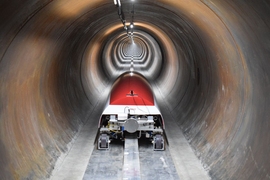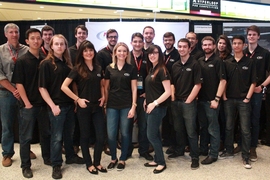Through dedication and a willingness to face challenges both expected and unforeseen, an MIT team recently brought the air-powered hovercraft from the world of Saturday-morning cartoons to reality, at the 2019 SpaceX Hyperloop Pod Competition.
But that’s only part of the story.
What’s past is prologue
In a 2013 white paper, Elon Musk, technology entrepreneur, investor, and engineer, detailed a high-speed frictionless train — the Hyperloop. When drag and atmosphere were removed from a tunnel, he posited, trains could float within a vacuum tube at up to 700 miles per hour.
Musk wasn’t the first to imagine an air-powered train. In the 1860s, Alfred Ely Beach, inventor, publisher, and patent lawyer, envisioned a subway under the streets of New York City. In 1870, his experiments in pneumatic power resulted in a demonstration run of the Beach Pneumatic Transit, a 10-passenger car propelled by a 100-horsepower fan, baffles, and blowers, through a tunnel beneath Broadway. His efforts were thwarted by Tammany Hall politics and the Panic of 1873.
It took the MIT team, dubbed Hyperloop II, to once more embrace Beach’s concept. “We took Beach’s vision and accomplished a much more efficient pneumatic vehicle,” explains Vik Parthiban, team captain.
Lofty goals
Parthiban, a graduate researcher at the MIT Media Lab, was part of the 2017 SpaceX Hyperloop Pod Competition during his undergraduate years at the University of Texas. He came to MIT determined to further the technology and, in the fall of 2018, recruited nearly 30 undergraduate and graduate students to develop an autonomous electric hovercraft.
“Imagine an air hockey puck,” explains Parthiban. “Instead of air coming out of a table, it comes out of pucks under the vehicle. A regulation system pumps air into these air castors, which then levitate the vehicle.” Four castors beneath the vehicle are operated by a pneumatic system controlled by a central computer. The propulsion system takes the 200-kilogram vehicle from zero to 200 miles per hour in 20 seconds with the push of a finger.
High-speed passenger trains in China and Japan use magnetic levitation to create a gap between the train and the track to remove the drag, but Parthiban took a different approach. “Putting magnetic levitation in a hyperloop is expensive,” he says. “Our goal was to invent a new technology that would cost less and be more efficient than magnetic levitation, and to develop an electric hovercraft that would work even without a vacuum tunnel. The only thing needed is a flat surface.”
The process
With support from the Edgerton Center and industry sponsors including Arrow Electronics, Silicon Expert, and Texas Guadaloop, the group joined forces to contribute individual skills. “We worked together to figure out the best way to integrate the components. Every person brought their own knowledge,” says Nick Dowmon, software engineering lead and a System Design and Management (SDM) graduate student. “It was an awesome learning opportunity and a chance to collaborate and learn from each other.”
Over the winter, the team met in the Edgerton Center’s build space to create a machine no one had ever built before. They brainstormed, designed, and redesigned. They machined parts, outsourcing the more complex components. They collaborated with the University of Texas on pneumatics and conducted analyses to determine the type of sensors needed to levitate and propel the pod at the required speed, adjusting here, fine-tuning there. They fashioned the 70-component wiring harness and constructed a test track in a 200-foot-long corridor beneath MIT’s Great Dome.
On May 22, the completed pod was presented at the MIT Museum to an overflow crowd eager to view the world’s first electric hovercraft.
A minor setback
In early summer, the production schedule was on target. Team members were confident the pod would meet its delivery deadline and reach California by July 7. On June 18, Parthiban and two teammates bent over the pod in the build space, intent upon working out last-minute details.
Then Parthiban saw flames. A tear in the battery insulation had caused a short, and he reached for a fire extinguisher. But the blaze quickly escalated, he recalls, and he reached for the fire alarm instead.
“The battery insulation fire burned down most of the vehicle,” he says. “It was the saddest thing.”
Parthiban called an emergency team meeting that evening, and within two hours, every team member had arrived — including those who’d left the project to focus on research and internships. Parthiban explained that rebuilding the pod in three weeks was virtually impossible.
But in true MIT style, every team member came together in a resounding “Let’s do this!”
“Everyone agreed we had to make it happen,” says Bowen Zeng, levitation lead and a graduate student in mechanical engineering. “There was no choice.”
“We had to drop everything to rebuild the pod before we went to California,” says Dowmon. “Many times, I was still in the build space at midnight with someone that I didn’t normally work with toiling on a part of the pod, but we helped each other. We worked through it together.”
Three days after the meeting, the pneumatic panel was rebuilt. In a week, the new chassis was finished. The electronic systems were recreated. Sponsors fast-tracked the delivery of replacement components. And a week before the shipping deadline, the pod was finished (again).
“I don’t think I’ve ever worked with a team that was so dedicated, so able to keep on going after something so discouraging,” adds Jessica Harsono, braking team lead and graduate student in mechanical engineering.
MIT’s entry was the only fully-functioning levitating pod in the competition at SpaceX headquarters in July. “Competition week was truly where our collaboration paid off,” says Parthiban. “With only a few people in California, we had to split the tasks and get parts and do the machining in a short amount of time, under deadline. But we made it.”
The MIT team emerged as the No. 1 U.S. university at the annual competition and placed fifth worldwide. They also earned a SpaceX Innovation award.
Only at MIT
Beach laid the groundwork and Musk provided the opportunity, but in the end, it was the spirit of camaraderie and teamwork that made the MIT team’s hyperloop a reality.
“My motivation wasn’t that I wanted to achieve this for myself,” says Harsono. “So many other people worked so hard, and I didn’t want to let them down. I was motivated out of respect for what they’d done and how much effort and care they put in.”
“This only can happen at MIT,” Parthiban says. “We all have that same mindset, the same hard-work attitude.”











